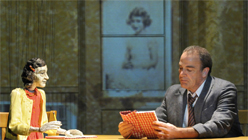Compulsion, Rinnie Groff’s profound work of historical fiction, shows how the concerns of the era — anti-Semitism, assimilation, Zionism, McCarthyism, as well as the intersection of business and art — all became factors in the adaptation of Anne Frank’s diary. At least these -isms were perceived to be major factors in the eyes of Sid Silver. Groff’s play seems to suggest that although Silver may have been paranoid, that doesn’t mean they weren’t out to get him.

Director Oskar Eustis (who will bring the play to New York next) deftly chisels the social, political and psychological nuances. As Silver, Patinkin tightropes between acting out of moral compulsion and being a fanatical obsessive. For Silver, Anne Frank’s remaining words are her remains. When he first brings Anne Frank’s diary to Doubleday, the publisher refers to it as the “adolescent diary by the Jewess.” In an era of gentlemen’s agreements and surnames that “pass,” Silver was protective of Anne Frank’s diary and wary of those who would touch it — be they Eleanor Roosevelt (who wrote the diary’s introduction) or Carson McCullers (who was asked to write the adaptation for the stage) or Lillian Hellman (whose politics may or may not have induced her to undermine Silver.)
Silver seemed to think that if he could craft the play just so, American audiences would comprehend the Holocaust and the Jewish experience just so, too. But his version was too Jewish. Or he was too impossible to work with. In the end, The Diary of Anne Frank was written by Albert Hackett and Frances Goodrich (who ironically, wrote the Christmas classic It’s a Wonderful Life). In their version, human suffering is universal; this time around, it was the Jews’ turn. The original diary’s references to Jews as victims and Germans as killers were removed. Anne’s seemingly forgiving “I still believe…” gets the play’s final word. The play was reviewed as a “lovely, tender drama.”

Hannah Cabell plays Silver’s wife, a performance which grows in poignancy as the wife gradually watches her husband become unhinged from the ordeal. Silver spent his money on lawsuits; he squandered his credibility and talents and sacrificed his marriage, his family and his peace of mind. Cabell also plays Miss Mermin, the young publisher at Doubleday whose allegiance towards Silver is challenged by his monomania. Matte Osian plays several roles, including bottom-line oriented anti-Semites. In this three-actor play, the stage is also peopled by marionettes. Designed by Matt Acheson, the puppets include Anne and Otto Frank and seem to represent the ghosts of unnamed Holocaust victims.
In the play’s most achingly intense scene, the puppet of Anne Frank appears in the Silvers’ bed. What begins as a familiar trope — the other woman between them — becomes a heartbreaking conversation between a mother and a dead child. As Anne describes her final days, and her father’s sorrow, the scene pierces with the truth of what was lost and what transpired in Bergen-Belsen. Here, and elsewhere, Compulsion achieves the rawness and beauty that Hackett and Goodrich’s “lovely drama” did not. Even more, Mandy Patinkin distills this rawness and beauty to one throe of quiet sorrow as he sings, in a mournful countertenor, a Yiddish song, after rising from the bed where he channeled Anne Frank.
Compulsion runs through October 31, 2010 at Berkeley Repertory Theater. For tickets and information visit berkeleyrep.org.





